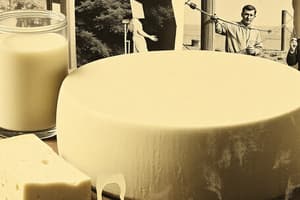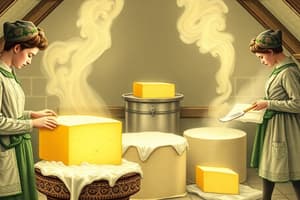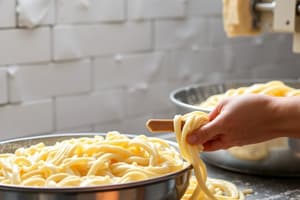Podcast
Questions and Answers
What is the common starting point for all cheese production?
What is the common starting point for all cheese production?
- Calf stomach
- Grapes
- Milk (correct)
- Cow's milk
Which type of milk is not commonly used for cheese production?
Which type of milk is not commonly used for cheese production?
- Grape juice (correct)
- Camel milk
- Buffalo milk
- Cow's milk
What process is a controversial subject in cheese production?
What process is a controversial subject in cheese production?
- Curdling
- Fermentation
- Aging
- Pasteurisation (correct)
According to connoisseurs, what is required to make a truly great cheese?
According to connoisseurs, what is required to make a truly great cheese?
Why do food technologists argue that pasteurisation is desirable?
Why do food technologists argue that pasteurisation is desirable?
What is a challenge in monitoring the quality of raw milk?
What is a challenge in monitoring the quality of raw milk?
How do farmhouse cheesemakers typically source their milk?
How do farmhouse cheesemakers typically source their milk?
Who is pressuring farmhouse cheesemakers to pasteurise their milk?
Who is pressuring farmhouse cheesemakers to pasteurise their milk?
What is the goal of several organisations battling for farmhouse cheesemakers?
What is the goal of several organisations battling for farmhouse cheesemakers?
What is the reason a skilled cheese maker can still make superb cheese with pasteurised milk?
What is the reason a skilled cheese maker can still make superb cheese with pasteurised milk?
What type of cheese is Cheddar?
What type of cheese is Cheddar?
Which of the following cheeses is not a type of Hard cheese?
Which of the following cheeses is not a type of Hard cheese?
Why should cheese not be stored in a warm kitchen for long?
Why should cheese not be stored in a warm kitchen for long?
How should blue cheese, particularly those without a thin rind, be wrapped?
How should blue cheese, particularly those without a thin rind, be wrapped?
What is the recommended way to store cheese for perfection?
What is the recommended way to store cheese for perfection?
Why is it better not to freeze cheese?
Why is it better not to freeze cheese?
What is the primary difference between the rind of cheese made from pasteurized milk and that from unpasteurised milk?
What is the primary difference between the rind of cheese made from pasteurized milk and that from unpasteurised milk?
When selecting a cheese, what should you look for in terms of its appearance?
When selecting a cheese, what should you look for in terms of its appearance?
How can cheese be served in a restaurant?
How can cheese be served in a restaurant?
What type of milk is used to make cream cheese?
What type of milk is used to make cream cheese?
What is the traditional French way of eating cheese during a meal?
What is the traditional French way of eating cheese during a meal?
What is the name of the mould used to develop the bloomy white rind on soft spreadable cheeses?
What is the name of the mould used to develop the bloomy white rind on soft spreadable cheeses?
Why should cheese be removed from the fridge a few hours before serving?
Why should cheese be removed from the fridge a few hours before serving?
What percentage of water do soft and semi-soft cheeses typically contain?
What percentage of water do soft and semi-soft cheeses typically contain?
What type of cheese is Gruyère?
What type of cheese is Gruyère?
Which type of cheese is often crumbly, springy but still moist?
Which type of cheese is often crumbly, springy but still moist?
What is the purpose of the Label of Origin on cheese?
What is the purpose of the Label of Origin on cheese?
Why is it essential to know the character of the cheese when buying?
Why is it essential to know the character of the cheese when buying?
What type of cheese should be kept refrigerated and eaten within 2 days?
What type of cheese should be kept refrigerated and eaten within 2 days?
What is the name of the culture used to develop the rind of semi-soft cheeses?
What is the name of the culture used to develop the rind of semi-soft cheeses?
What is the ideal number of cheeses to include on a Cheese Board?
What is the ideal number of cheeses to include on a Cheese Board?
What type of cheese is Cooleeney or Carrigbyrne Camembert?
What type of cheese is Cooleeney or Carrigbyrne Camembert?
What is the role of a cheese waiter or waitress?
What is the role of a cheese waiter or waitress?
What is the recommended accompaniment to serve with cheese?
What is the recommended accompaniment to serve with cheese?
What is a popular trend in serving cheese in Australia and the United States?
What is a popular trend in serving cheese in Australia and the United States?
What is membrillo often paired with?
What is membrillo often paired with?
What is the purpose of a cheese course?
What is the purpose of a cheese course?
What type of nut is often paired with cheese?
What type of nut is often paired with cheese?
What is the reason for serving cheese with honey?
What is the reason for serving cheese with honey?
What is the purpose of relishes in a cheese course?
What is the purpose of relishes in a cheese course?
Flashcards are hidden until you start studying
Study Notes
Intro to Cheese
- All cheese starts with milk, which can come from cows, goats, sheep, buffalo, or camels.
- Milk sours and curdles naturally, which may have led to the accidental discovery of cheese.
- Most cheese is made from pasteurized milk, but some argue that unpasteurized milk is necessary for truly great cheese.
Pasteurization Debate
- Pasteurization kills natural bacteria, which can affect the flavor and character of the cheese.
- Connoisseurs argue that unpasteurized milk is necessary for unique flavor and character.
- Food technologists argue that pasteurization allows for control over quality and introduction of specific starters.
Labels and Origins
- Many cheeses carry a Label of Origin, which indicates the type of milk, fat content, and production methods.
- Labels may also indicate if the cheese is made in a farmhouse or factory, and whether it's made from pasteurized or unpasteurized milk.
- Examples of Label of Origin cheeses include Parmigiano Reggiano (Italy), Gruyère and Emmental (Switzerland).
Cheese Characteristics
- Soft cheese: firm to the touch in the center, soft and creamy towards the edge; may have a white or reddish-brown rind.
- Hard or semi-hard cheese: freshly cut, no dry or oily appearance on the cut side; may have a mould on the skin or rind.
- VERY SOFT cheese: uncooked and unripened, must be kept refrigerated and consumed within 2 days.
Cheese Classification
- Cheese can be divided into 5 groups:
- Soft and semi-soft (ripened)
- Soft (spreadable)
- Semi-soft (firmer, crumbly, springy)
- Semi-hard (sliced easily)
- Hard (pressed, dense, grated when old)
Storing Cheese
- Ideal storage: cool larder or cupboard, high humidity, wrapped individually in clean damp tea towel or greaseproof paper.
- Avoid storing cheese in a warm kitchen, fridge, or with cling film.
- Special wrapping has been developed for storing cheese, such as silver or gold foil for blue cheese.
Cheese Service
- Cheese can be served in several ways:
- One single cheese in perfect condition
- A selection of cheese on a plate
- A cheese board or basket with a choice of 3 to 5 cheeses
- A cheese trolley with a large selection of cheese
- Cheese presentation: timber board, marble slab, or flat basket covered with fresh vine or fig leaves.
Accompaniments to Cheese
- Simple accompaniments: fresh crusty homemade white bread or simple cheese biscuits
- Trending accompaniments: nuts, dried fruit, relishes, salads, crackers, or flavored breads.
- Examples of accompaniments: fresh walnuts, dried Turkish figs, honey, membrillo, or quince cheese.
Studying That Suits You
Use AI to generate personalized quizzes and flashcards to suit your learning preferences.




